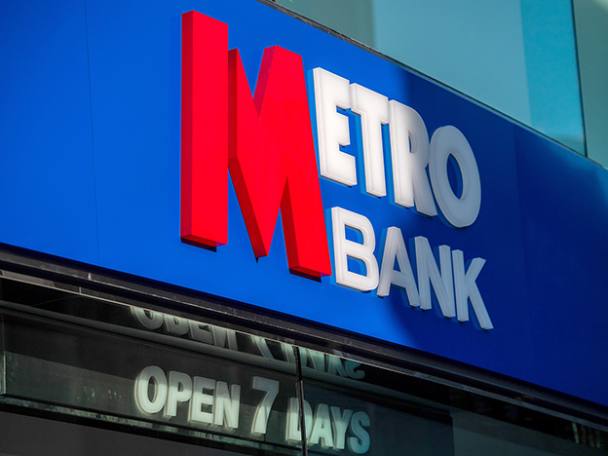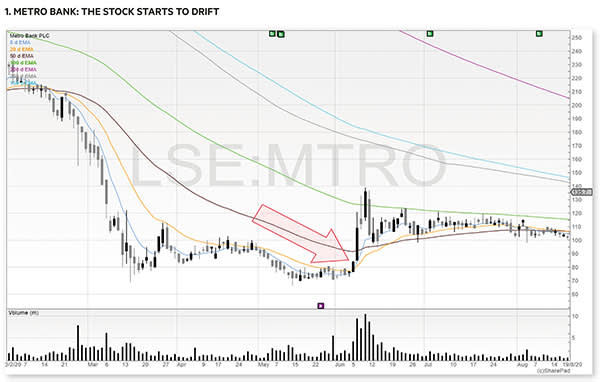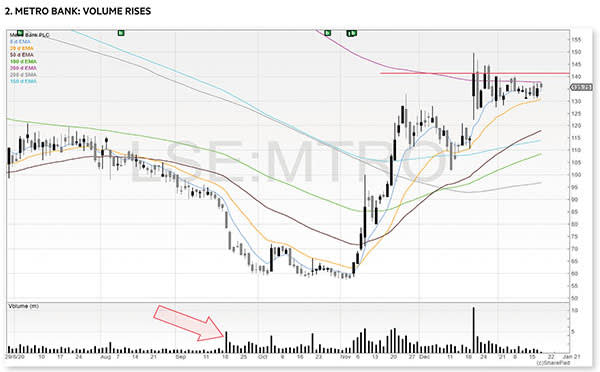- High street bank's shares have had a rocky ride since listing
- Recent uptick in volume has led to upwards price action and opportunities to trade this momentum
In 2010, Metro Bank (MTRO) became the first high street bank to be granted a license by the old Financial Services Authority (currently Financial Conduct Authority) in over 150 years. Its first branch opened just over a decade ago in Holborn and six years later it joined the stock exchange.
It was valued at £1.6bn on listing and from there the share price almost doubled, closing above 4,000p for a few days.
The fact that the shares now trade below 140p is a sharp reminder that the stock market is not a place of guaranteed riches. That warning appears to have been forgotten in recent months, though, as scores of new traders pile into the market. As Bronte Capital wrote in a recent newsletter: “When you think the retail investors being promoted this new shiny fraud (that they cannot possibly know anything about) are hitting exhaustion, a new wave of newbies – with their Robinhood accounts – comes to bid your short up double or triple.”
Bronte Capital is a fund that aggressively shorts stocks that are promoted to retail investors, and unsurprisingly it’s had a tough year. It’s unlikely that anyone will be rushing for the violins, though – I have watched as shorters announce positions on social media along with their reasoning only to be met with a torrent of abuse. When confirmation bias runs so high it becomes almost a cult, any dissenter is a target that must be discredited and destroyed.
That’s one reason why manias, however irrational they seem, can keep going. Indeed, new gurus are popping up on TikTok, a Chinese social media platform where users record short videos. One such character was telling his audience how he makes more than $14,000 a month by employing this super strategy: “I see a stock going up and I buy it, and I just watch it until it stops going up, and then I sell it. And I do that over and over, and it pays for our whole lifestyle”. Yes, that is a verbatim quote.
Make no mistake – we are entering market froth. One common question is, how long can it last? An honest answer might be, how long is a piece of string? But for now, as Leonardo di Caprio says in The Wolf of Wall Street: “The show goes on!”
Looking at Chart 1, volatility has been no stranger to Metro Bank. The stock came onto my radar from my volume filter, and we can see that the stock rose sharply in the next few sessions. But those who were hoping for a sustained move were left disappointed, as both volume and volatility both dropped and the stock began to drift.
The problem with trading stocks that are on the lows is that there is no confirmation that the stock has moved into a defined trend. It’s much easier to jump onboard a moving stock, as it already has momentum. As we’ve seen with momentum in stocks in the US, it doesn’t matter how overvalued a stock is – it can always become more overvalued. This is why I prefer early stage-2 trends, where the stock is nicely up from the lows and at least giving some confirmation that the trend may be changing.
That could now be happening, as we can see if we look across to Chart 2. I’ve marked an arrow on the stock where there was a sudden jump in volume and a sustained increase over the weeks that followed. We can also see that the stock started to make a base – although the volatility still ranged from the low 50s to 70p. The stock quickly came close to doubling, hitting 100p in just a few sessions. This marked the price as resistance, and I tweeted that I would be taking a long position if the stock broke through this resistance. Remember, much of the market is human psychology and emotions. 100p is a round number and often a stock will mark these round numbers as support and resistance, purely because humans are buying and selling at these levels.
The stock did break through this level and netted a nice trade. It did pull back to test this but gapped up on the news of the sale of the company’s £3bn residential mortgage portfolio, netting the bank an £83m gain and giving its balance sheet a much-needed boost. We can see that this was well received due to the gap up and volume increase on the day of the news, and since then the stock has been consolidating in a range over the last few weeks.
I intend to take a long position if the stock can break out of the red line marked. We can see the stock is tussling with the 200-day exponential moving average (pink line) and reducing in both volume and volatility. It’s also forming a base, which means we can put our stop-loss below this base relatively tight, but still out of the way of the stop-loss liquidity. I have no idea whether Metro Bank is a good stock to invest in from a fundamental perspective – as of 17 January 2021, 5.11 per cent of outstanding shares in Metro Bank were sold short.
But this (as always) is a trade based on the chart strength and price action analysis. I have no qualms about buying higher than where I sold my last previous trade, because my previous trade at 100p was a good trade in terms of risk/reward – and so is this one, and I’m a buyer if it breaks through 141p. If you didn’t allow yourself to buy shares that printed higher after you sold them, then as a trader you’d never trade at all. My first buy of Sylvania Platinum was 7p. It printed 120p today, and I’ve traded it more times than I can remember.
- Michael has started his Buy the Breakout newsletter which contains trading ideas and tips he has learned whilst trading. You can subscribe for free at his website here: www.shiftingshares.com
- Twitter: @shiftingshares
- New subscribers to SharePad can claim a free month of data with the code: Michael










